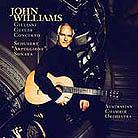October 1999
Popular Australian classical guitarist John Williams returns to his homeland for this recording. Joined by the Australian Chamber Orchestra, Williams gives a stellar performance on this disc. The first piece, Schubert’s Sonata Arpeggione D 821, is a work Schubert wrote for a virtuoso named Vincent Schuster to be played on an instrument called the arpeggione, a six-string instrument with frets and tuning like a guitar, but held between the legs and played with a bow. While the arpeggione never caught on, the work has lived on in arrangements for viola and cello. The combination of modern and period instruments gives the 16-member chamber orchestra a unique sound. On this piece, Williams plays his guitar, a custom Greg Smallman classical. The first movement opens with the catchy, lyrical theme of the piece. Interestingly, the theme is more reminiscent of Schubert’s lieder than his orchestral works. The second movement contemplates the theme, while the cheerful allegretto will have you tapping your foot and humming the tune later on. All in all, this is a very fun piece of music. The second piece is Concerto No. 1 in A major, Op. 30 by Mauro Guiliani (1781-1829). Although Schubert and Guiliani died within a year of each other, they couldn’t really be considered contemporaries. Guiliani was 16 years older than Schubert, and Mozart’s influence on Guiliani’s style is evident. This Concerto is also unique in that Williams plays a period instrument, an 1814 Gaetano Guadignini guitar. The Guadignini has a shallower body than the modern guitar and sounds different in a way similar to what you would hear between the modern piano and the fortepiano. Although less full-bodied, the seeming shallow sound allows the rapid passages to come across clearly without getting lost in a sonorous acoustic drone. The orchestra has a greater role in the Concerto, and the youthful exuberance of the youngish-looking orchestra serves the piece well. The three-movement Concerto is somewhat more challenging to the guitarist, which is what one might expect since Guiliani wrote mainly for the guitar. On both pieces, Williams’ skillful playing nicely complements the orchestra, which, in turn, allows the guitarist to convey the joy of both compositions. This Sony Classical recording is exceptional in that it doesn’t have the usual edginess I hear on many Sony recordings. The soundstage is realistic, with Williams sitting in front, just to the left of center. Excellent miking allows you to hear the unique timbre of both instruments and Williams’ fingering techniques. Likely thanks for the fine recording go to the engineers, Allan Maclean and Bob Whitney. Sony wold be wise to sign them on for the long haul. This is a disc I think every guitarist will enjoy and one with which to introduce classical music to the newcomer. GO BACK TO: |
 John Williams - Plays
Schubert and Guiliani
John Williams - Plays
Schubert and Guiliani![[Reviewed on CD]](../format/regcd.gif) Can you
identify with this? Your musically challenged best friend just comes over all excited with
his new Celine Dion CD in hand. He really wants to hear it on your killer sound system.
You’ve been trying to enlighten him to the wonders of classical music, but the
Shostakovich string quartets you’ve played for him haven’t really won him over.
Well, I think I have your CD.
Can you
identify with this? Your musically challenged best friend just comes over all excited with
his new Celine Dion CD in hand. He really wants to hear it on your killer sound system.
You’ve been trying to enlighten him to the wonders of classical music, but the
Shostakovich string quartets you’ve played for him haven’t really won him over.
Well, I think I have your CD.